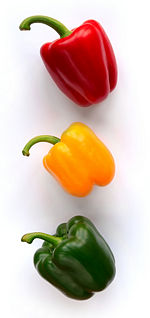Bell pepper
| Bell pepper | ||||||||||||||||
|---|---|---|---|---|---|---|---|---|---|---|---|---|---|---|---|---|
 Red, yellow and green pepper
| ||||||||||||||||
| Scientific classification | ||||||||||||||||
| ||||||||||||||||
| Capsicum annuum L. |
| Heat: None (SR: 0) |
| Pepper, sweet, green raw Nutritional value per 100 g | ||||||||||||||||||||||||||||||||||
|---|---|---|---|---|---|---|---|---|---|---|---|---|---|---|---|---|---|---|---|---|---|---|---|---|---|---|---|---|---|---|---|---|---|---|
| Energy 20 kcal 80 kJ | ||||||||||||||||||||||||||||||||||
| ||||||||||||||||||||||||||||||||||
| Percentages are relative to US recommendations for adults. Source: USDA Nutrient database | ||||||||||||||||||||||||||||||||||
Bell pepper is a cultivar group of the species Capsicum annuum. Cultivars of the plant produce peppercorns which develop into fruits in different colors, including red, yellow, green and orange. Bell peppers are sometimes grouped with less pungent pepper varieties as "sweet peppers".
Overview
Solanaceae is a family of flowering plants in the Solanales order, characterized by five-petaled flowers, typically conical or funnelform, and alternate or alternate to opposite leaves, and including some of the more important food and drug-producing plants, including potato, tomato, eggplant, tobacco, chili pepper, and deadly nightshade.
Nomenclature
The term "bell pepper" is one of the many names for some fruits of the Capsicum annuum species of plants. The misleading name "pepper" (pimiento in Spanish) was given by Christopher Columbus upon bringing the plant back to Europe. At that time peppercorns were a highly prized condiment.
Today, the term "bell pepper" or "pepper" or "capsicum" is often used for any of the large bell shaped capsicum fruits, regardless of their color. In British English, the fruit is simply referred to as a "pepper", whereas in many Commonwealth of Nations countries, such as Australia, India, Malaysia and New Zealand, they are called "capsicum". Across Europe, the term "paprika", which has its roots in the word for pepper, is used—sometimes referred to by their color (e.g. "groene paprika", "gele paprika", in Dutch, which are green and yellow, respectively). Paprika also refers to the powdered spice made from the same fruit. In France it is called "poivron" or "piment." In Japan, the word ピーマン ("pîman," from the French) refers only to green bell peppers, whereas パプリカ ("papurika," from paprika) refers to bell peppers of other colors. In the United States and Canada, the fruit is often referred to simply as a "pepper" or referred to by color (e.g. "red pepper", "green pepper"), although the more specific term "bell pepper" is understood in most regions. It is also to be noted that Bell Peppers are indeed fruits, even though most treat them as vegetables.
In parts of the U.S. around southern Ohio, Northeastern Pennsylvania and northern Kentucky the term "mangoes" (or "mangos") has sometimes been used to refer to bell peppers. However, as the actual mango fruit has become more common in the region, this usage has faded.
In Russia it is commonly called болгарский перец (bolgarskiy perets), meaning Bulgarian pepper. In France, it is called poivron, with the same root as poivre (meaning black pepper). In Denmark the bell pepper is referred to as "peberfrugt", meaning pepper-fruit.
In Brazil it's commonly called Pimentão, meaning Big pepper. It's widely used in a variety of dishes, like pasta, rice and other dishes from Cuisine of Brazil.
Varieties
The color can be green, red, yellow, orange and, more rarely, white, purple, blue, and brown, depending on when they are harvested and the specific cultivar. Green peppers are unripe bell peppers, while the others are all ripe, with the color variation based on cultivar selection. Because they are unripe, green peppers are less sweet and slightly more bitter than yellow, orange, purple or red peppers. The taste of ripe peppers can also vary with growing conditions and post-harvest storage treatment; the sweetest are fruit allowed to ripen fully on the plant in full sunshine, while fruit harvested green and after-ripened in storage are less sweet. Peppers are native to Central and South America. Pepper seeds were later carried to Spain in 1493 and from there spread to other European and Asian countries.
In popular culture
Gallery
See also
- List of capsicum cultivars
- Scoville scale
- Paprika
ReferencesISBN links support NWE through referral fees
- ↑ The Muppets And Jessica Simpson In Pizza Hut Commercial. The Wrong Advice. Retrieved 2008-05-15.
- George Mateljan Foundation (GMF). 2008. Bell peppers. World's Healthiest Foods. Retieved June 3, 2008.
- Germplasm Resources Information Network (GRIN). 2008a. Capsicum annuum L. var. annuum USDA, ARS, National Genetic Resources Program. Germplasm Resources Information Network. Retrieved June 3, 2008.
- Integrated Taxonomic Information System (ITIS). 1999a. Solanaceae ITIS Taxonomic Serial No.: 30411. Retrieved May 25, 2008.
- Integrated Taxonomic Information System (ITIS). 1999b. Capsicum L. ITIS Taxonomic Serial No.: 30491. Retrieved May 25, 2008.
- Plants For a Future (PFAF). 2008. Capsicum annuum Plants For A Future. Retrieved June 3, 2008.
External links
- Bell Pepper page at World's Healthiest Foods
Credits
New World Encyclopedia writers and editors rewrote and completed the Wikipedia article in accordance with New World Encyclopedia standards. This article abides by terms of the Creative Commons CC-by-sa 3.0 License (CC-by-sa), which may be used and disseminated with proper attribution. Credit is due under the terms of this license that can reference both the New World Encyclopedia contributors and the selfless volunteer contributors of the Wikimedia Foundation. To cite this article click here for a list of acceptable citing formats.The history of earlier contributions by wikipedians is accessible to researchers here:
The history of this article since it was imported to New World Encyclopedia:
Note: Some restrictions may apply to use of individual images which are separately licensed.




